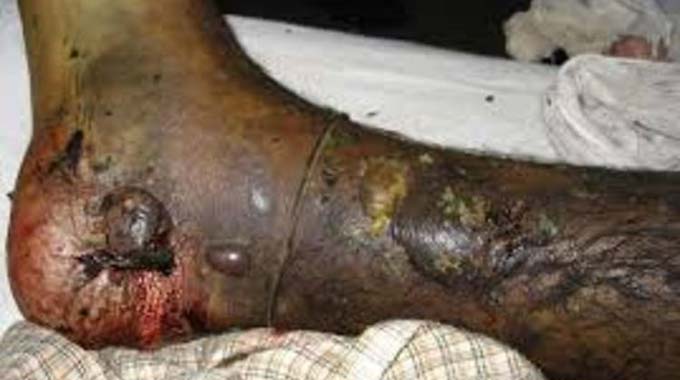Snakebite resolution set for Health Assembly approval

Aisling Irwin Correspondent
Efforts to tackle snakebite — a recent addition to the WHO’s list of neglected tropical diseases (NTDs) — will take a step forward this month with a resolution set to be approved at the World Health Assembly.
Campaigners hope this will be a milestone in unlocking finances for expensive anti-venoms, providing impetus for research and enabling more coordinated interventions.
Poisonous snake bites kill about 90 000 people a year, thousands more than other deadly NTDs, and leave a further 400 000 with lost limbs, blindness and trauma. They particularly affect the very poor, such as barefoot farmers in low and middle-income countries.
Tackling the problem is tricky for various reasons: for example, victims are often in remote areas and need treatment fast; health workers cannot easily identify the culprit with certainty; and anti-venom treatments are expensive.
The WHO resolution is sponsored by Costa Rica and Colombia and co-sponsored by 25 other countries.
It urges countries to assess impacts, share anti-venom technology, support research on new medical tools, and educate health workers about how to respond.
“We are really glad to see that quite a large number of countries are supporting it,” says Julien Potet of the medical charity Doctors without Borders (Medécins Sans Frontières-MSF).
“But it’s a first step . . . the next step is to really translate this resolution into a concrete plan at country level as well as an ambitious roadmap.”
Rafael Ruiz de Castañeda, of the Institute of Global Health in Geneva, agrees: “We feel that things are moving in a good direction but it’s only the beginning.”
As part of the resolution’s call to accelerate global efforts, in August the WHO will publish an eagerly awaited roadmap prioritising five action areas to encourage funding from donors.
Jose Louies, a wildlife expert from the Indian Snakebite Initiative, questions who will implement the roadmap on the ground. “It’s a visionary proposal but are we prepared to do all this in the field? (In India) we have a snakebite protocol that was published ten years back but how many hospitals follow this protocol?”
One key issue, which MSF has been campaigning on, is the need to manufacture more anti-venoms.
Production is expensive and the products — biological agents generated by manipulating the immune system of horses — have a short shelf-life.

The drug company Sanofi produced the last batch of its effective anti-venom in 2014. This means people affected by snake bites turn to poor-quality, cheaper anti-venoms.
MSF wants countries to band together to leverage better purchasing power with manufacturers, says its NTD adviser Julien Potet, drawing parallels with GAVI, a public-private alliance that has improved access to vaccines with this approach.
Another key issue is the dearth of basic information about the incidence of snakebite. “This is not only a humanitarian crisis . . . it’s a data crisis,” Castañeda tells SciDev.Net.
A few countries are trying to gather data. In India, where an estimated 50 000 people die of snakebite each year, the Big 4 Mapping Project has just completed its first year of real-time mapping to help build a picture of snake activity across the country.
It involved enlisting around a thousand screened volunteers — including snake-rescuers, naturalists and forestry workers — to upload photograph sightings of India’s four most medically important snakes, along with information such as location, time of day and weather. Louies, who runs the project, hopes to add mapping of actual snake bites and anti-venom stockists over the next few years.

Another project that began in March in Nepal and Cameroon, Snake-Byte, is looking to understand the epidemiology and impact of snakebite.
And an app developed by the same team at the Institute of Global Health, dubbed SNAPP, will use machine learning to help health workers by identifying a snake from a photo supplied by them, a victim or a bystander. MSF has recently signed up to collaborate with SNAPP, to contribute images and later test clinical applications of the tool.
Zimbabwe too, is grappling with the snake bites menace and widespread shortages of the anti venom.
Official figures show that more than 13 people have died from snake bites since the beginning of the year.
“The total snake bite cases reported during the week ending March 25, 2018 were 114 and one death. The cumulative figure for snake bites were 1 937 and 13 deaths,” the ministry said in its weekly surveillance update which was issued in April this year.
The figures indicate a decrease in cases of both snake bites and deaths compared to the same period last year.
In the first quarter of 2017, snake bites claimed 38 lives while the total number of those bitten were 5 605.
According to the African Snakebite Institute, Zimbabwe has 81 snake species, 48 of which are highly poisonous.
The biggest killer are puff adders which are responsible for up to 90 percent of cases of deaths.
Snake bites kill approximately 32 000 people in sub-Saharan Africa and leaves a 100 000 survivors nursing injuries, and some suffer permanent physical disabilities, according to a WHO study.
Kenya and Cameroon are the worst affected countries on the continent with Nigeria topping the list. The snake bites are a crisis in the region especially due to inadequate resources to respond to it on time.
Most African countries face an acute scarcity of snake anti-venom drugs.
Health experts say most of those affected live in isolated and less connected areas making access to medical facilities with specialist staff trained to diagnose and treat snake bite challenging.
They also say the issue has been neglected by governments and institutions across the region.
“Diagnosis and treatment of snakebites are no longer taught in medical and nursing schools. No country has a strategy for combating envenomation. There is no policy of selecting and distributing anti-venoms,” bemoaned one health expert in a report online. — Sci-Dev/The Herald.










Comments